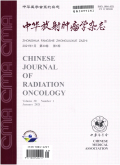儿童非典型性畸胎样/横纹肌样瘤放疗疗效及预后分析
Efficacy and prognosis after radiotherapy in pediatric atypical teratoid / rhabdoid tumors
摘要目的:分析非典型性畸胎样/横纹肌样瘤(AT/RT)患儿综合治疗的疗效及预后影响因素。方法:回顾性分析2012年11月至2022年9月于上海交通大学医学院附属新华医院肿瘤科行初次放疗的病理确诊为AT/RT儿童的临床资料。采用Pearson卡方检验或连续性校正卡方检验或Fisher确切概率法进行分类变量组间比较,采用独立样本 t检验或Wilcoxon秩和检验进行连续变量的组间比较;采用Kaplan-Meier法计算1、2年总生存(OS)率及无进展生存(PFS)率。采用单因素和多因素Cox回归分析来确定相关预后因素。 结果:共纳入45名患儿,其中诊断年龄≥3岁者27名,男女比例为1.65∶1。所有患儿均行手术及放疗,39例行化疗,41例行全中枢放疗(CSI),4例行全脑或局部瘤床放疗。中位随访时间为28(13.5,49)个月。综合治疗后共14例死亡。患儿1年OS率为80.0%,PFS率为71.1%。2年OS率为75.5%,PFS率为65.7%。生存预后分析提示放疗后无影像肿瘤残存( HR=0.087,95% CI为0.011~0.697, P=0.022)是PFS的有利因素。肿瘤原发灶<4.8 cm( HR=0.221,95% CI为0.052~0.935, P=0.040)及行CSI( HR=0.085,95% CI为0.011~0.651, P=0.018)是OS的有利因素。在亚组分析中,CSI也有利于提高≥3岁患儿OS期( HR=0.014,95% CI为0~0.470, P=0.017),但PFS无明显获益。在无脑脊液播散的患儿中,放疗后无影像肿瘤残存( HR=0.066,95% CI为0.009~0.481, P=0.007; HR=0.076,95% CI为0.008~0.695, P=0.024)及行CSI( HR=0.105,95% CI为0.012~0.937, P=0.044; HR=0.054,95% CI为0.005~0.629, P=0.020)是患儿PFS及OS的有利因素,肿瘤原发灶<4.8 cm也提示更长的OS期( HR=0.094,95% CI为0.013~0.690, P=0.020)。 结论:包括放疗在内的综合治疗模式提升了AT/RT患儿预后。放疗后无影像肿瘤残存与PFS改善相关;肿瘤原发灶<4.8 cm及行CSI是OS的有利因素;CSI也是≥3岁患儿及无脑脊液播散患儿的显著正面预后因素。
更多相关知识
abstractsObjective:To analyze the clinical efficacy and prognostic factors of comprehensive treatment for atypical teratoid / rhabdomyoma tumor (AT/RT).Methods:Clinical data of children diagnosed with AT/RT who underwent radiotherapy in Department of Oncology of Xinhua Hospital affiliated to Shanghai Jiao Tong University School of Medicine from November 2012 to September 2022 were retrospectively analyzed. Pearson Chi-square test or continuous-corrected Chi-square test or Fisher's exact probability method were used for inter-group comparison of categorical variables. Independent sample t-test or Wilcoxon rank-sum test were used for inter-group comparison of continuous variables. Kaplan-Meier method was used to calculate the 1-year and 2-year overall survival (OS) rate and progression free survival (PFS) rate. Univariate and multivariate Cox regression analyses were employed to determine relevant prognostic factors. Results:A total of 45 patients were included, with a male/female ratio of 1.65:1, including 27 children aged ≥3 years old. All patients received surgery and radiotherapy in which 39 patients received chemotherapy, 41 craniospinal irradiation (CSI), and 4 whole brain or focal radiation therapy. The median follow-up was 28 (13.5, 49) months. A total of 14 patients died after comprehensive treatment. The 1-year OS rate was 80.0% and the PFS rate was 71.1%. The 2-year OS rate was 75.5% and the PFS rate was 65.7%. Survival prognostic analysis showed negative imaging assessment after radiotherapy ( HR=0.087, 95% CI: 0.011-0.697, P=0.022) was a favorable factor for PFS. The primary tumor<4.8 cm ( HR=0.221, 95% CI: 0.052-0.935, P=0.040) and CSI ( HR=0.085, 95% CI: 0.011-0.651, P=0.018) were favorable factors for OS. In subgroup analysis, CSI also improved OS in children aged ≥3 years ( HR=0.014, 95% CI: 0-0.470, P=0.017), but there was no significant difference in PFS. In children without cerebrospinal fluid dissemination, negative radiographic results after radiotherapy ( HR=0.066, 95% CI: 0.009-0.481, P=0.007; HR=0.076, 95% CI: 0.008-0.695, P=0.024, respectively) and CSI (HR=0.105, 95% CI: 0.012-0.937, P=0.044; HR=0.054, 95% CI: 0.005-0.629, P=0.020, respectively) were favorable factors for PFS and OS in children, and the primary tumor<4.8 cm also suggested a longer OS ( HR=0.094, 95% CI: 0.013-0.690, P=0.020). Conclusions:Comprehensive treatment including radiotherapy improves clinical prognosis of children with AT/RT. Our study shows that negative imaging results after radiotherapy are associated with PFS improvement. The primary tumor<4.8 cm and CSI are favorable factors for OS. CSI is also a significantly positive prognostic factor in children aged ≥3 years and those without cerebrospinal fluid dissemination.
More相关知识
- 浏览0
- 被引0
- 下载0


相似文献
- 中文期刊
- 外文期刊
- 学位论文
- 会议论文



 换一批
换一批 换一批
换一批



